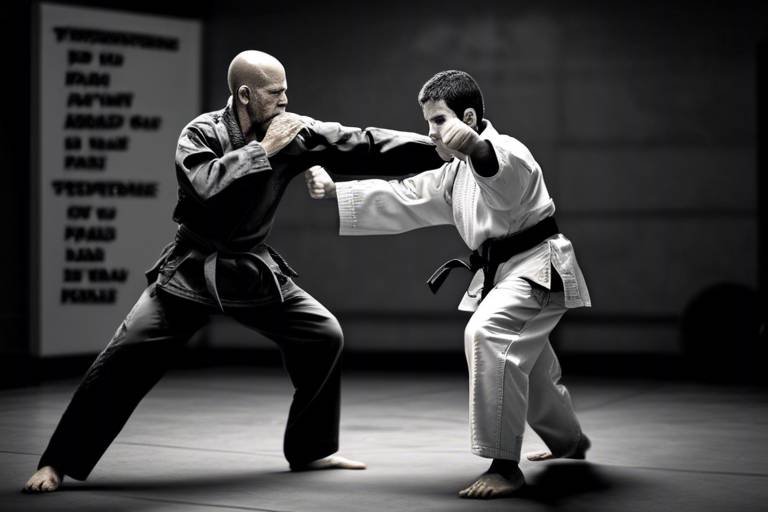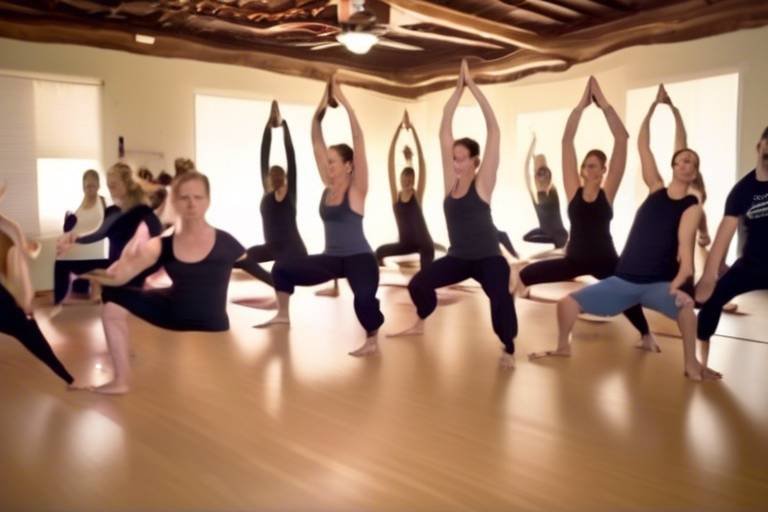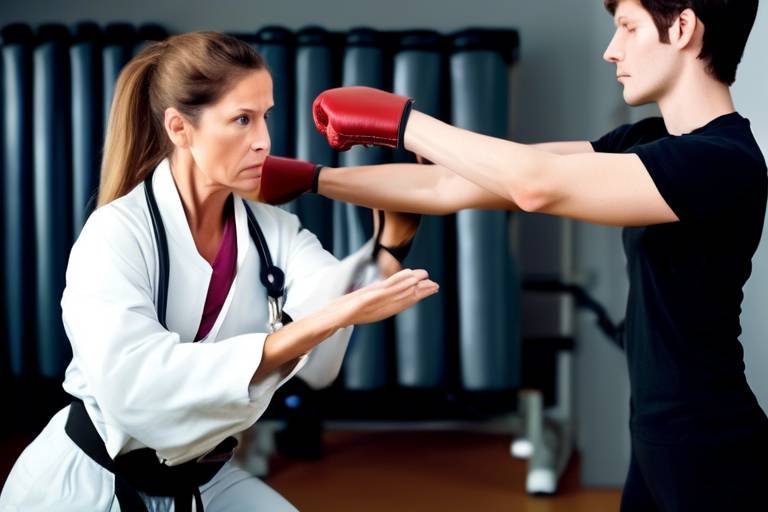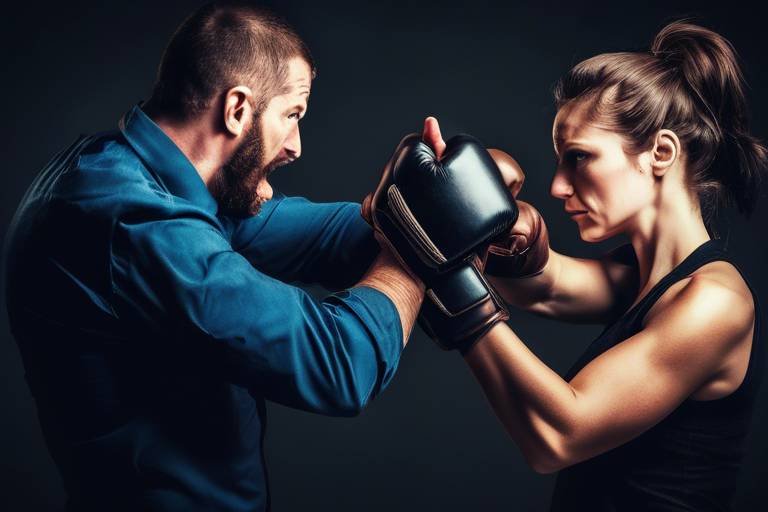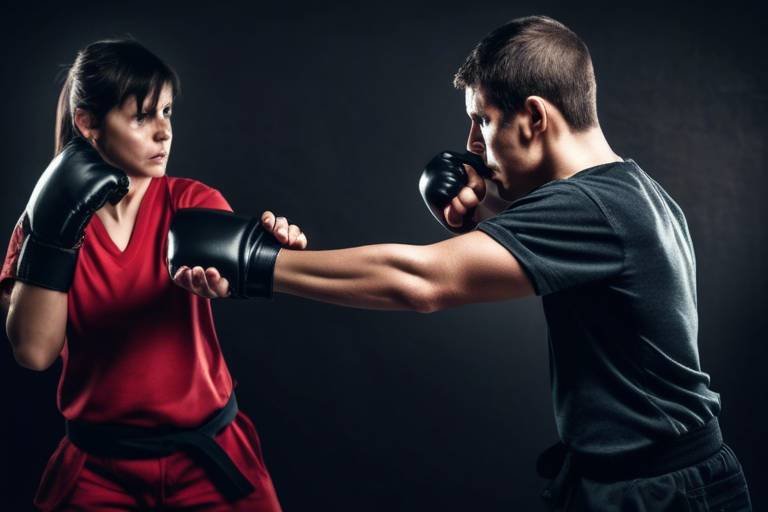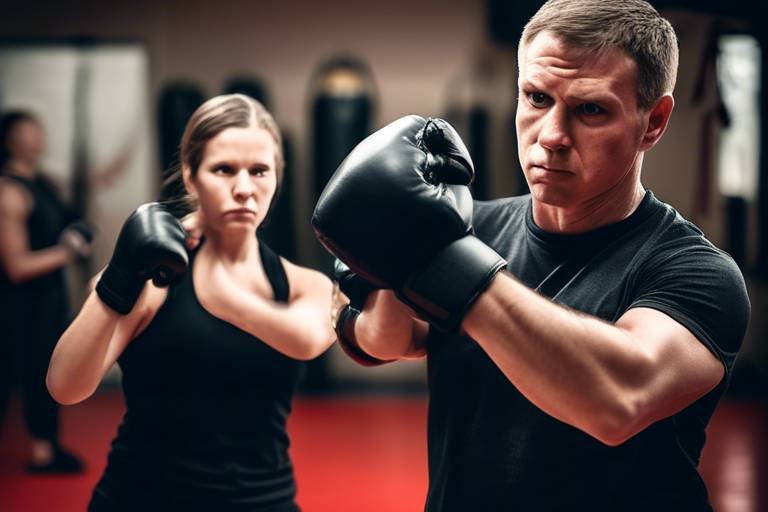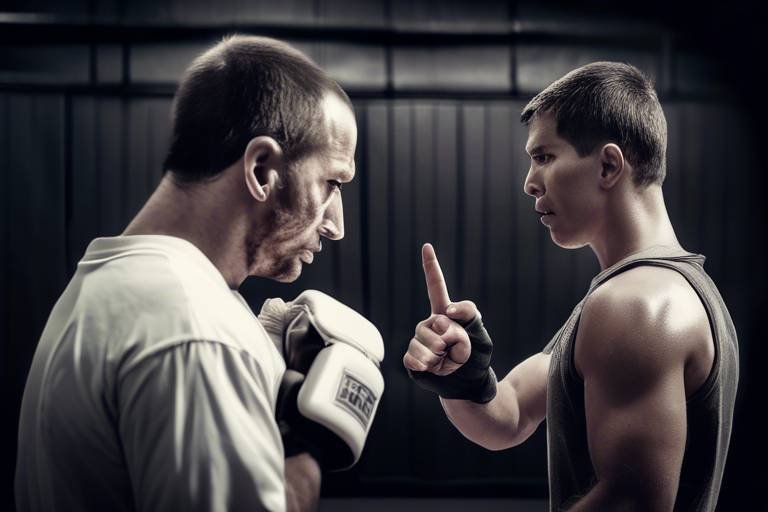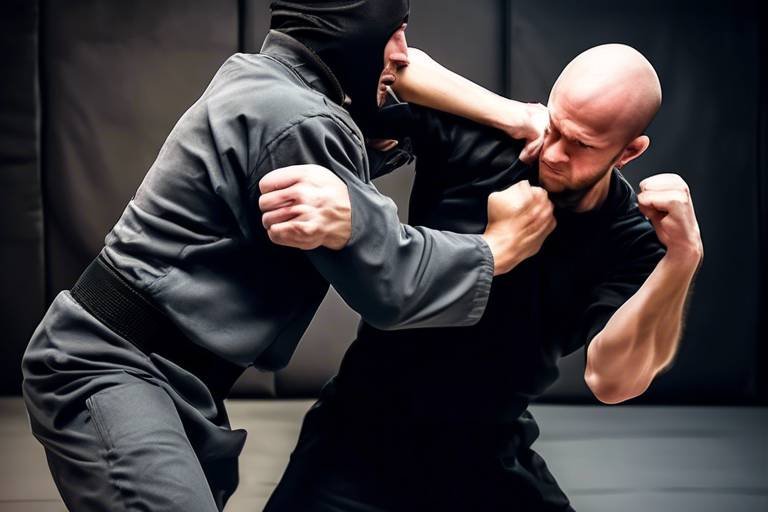How to Use Self-Defense Techniques Against Larger Attackers?
In a world where personal safety is paramount, knowing how to defend oneself, especially against larger attackers, is crucial. Imagine walking down a dimly lit street when suddenly, you find yourself confronted by someone significantly bigger than you. The instinctual response might be fear, but what if you could turn that fear into confidence? This article dives deep into effective self-defense strategies tailored for individuals who may find themselves facing larger opponents. We’ll explore practical techniques, psychological tips, and the importance of situational awareness, all designed to enhance your personal safety and boost your confidence in confrontational situations.
When it comes to self-defense, the dynamics of size play a pivotal role in confrontations. Larger individuals often possess advantages in strength and reach, making them formidable opponents. However, this doesn't mean that smaller individuals are defenseless. In fact, understanding how size influences a confrontation can be the first step toward developing effective self-defense strategies. Smaller individuals may excel in agility and speed, allowing them to maneuver around their larger counterparts. It’s a classic David versus Goliath scenario, where strategy and technique can triumph over brute strength. Recognizing these dynamics can empower you to approach self-defense with a mindset focused on leveraging your unique strengths.
Now that we understand the dynamics of size, let's delve into essential self-defense techniques specifically designed for smaller individuals. The key here lies in leveraging your speed and agility rather than trying to match the strength of a larger attacker. Techniques that focus on body mechanics, joint locks, and striking can provide effective means of defense. Remember, the goal is not just to defend but to create an opportunity for escape.
Understanding body mechanics is crucial for effective self-defense. Proper body positioning and movement can help smaller individuals gain an advantage over larger adversaries. For instance, using your hips and core to generate power can amplify the effectiveness of your strikes. Think of your body as a coiled spring; when you release that energy, it can deliver a surprising amount of force. Additionally, maintaining a low center of gravity can enhance your stability, making it harder for a larger attacker to overpower you.
Joint locks and pressure points can incapacitate larger attackers, providing a critical advantage. These techniques focus on manipulating an opponent's joints or applying pressure to sensitive areas of the body. For example, a simple wrist lock can render a larger individual momentarily incapacitated, allowing you to escape. It's essential to practice these techniques regularly to execute them effectively in high-pressure situations. Remember, the element of surprise can be your best ally.
Striking techniques that emphasize speed and precision are vital for smaller individuals. Quick jabs to vulnerable areas, like the eyes or throat, can incapacitate a larger attacker long enough for you to escape. Think of your strikes as quick bursts of energy rather than trying to deliver a knockout punch. The goal is to create an opening, not to engage in a prolonged fight. Training in martial arts can significantly enhance your striking capabilities and boost your confidence in a confrontation.
Mental preparedness is just as vital as physical techniques in self-defense. Psychological tactics can help smaller individuals maintain confidence and composure during confrontations with larger attackers. Visualization techniques, for instance, can mentally prepare you for various scenarios, allowing you to react instinctively when faced with danger. Additionally, maintaining a confident posture can deter potential aggressors, as they often seek easy targets. Remember, confidence can be your strongest weapon.
Situational awareness is key to avoiding confrontations altogether. By recognizing potential threats and implementing preventive measures, you can enhance your personal safety before an altercation occurs. This proactive approach is crucial in today’s unpredictable world.
Identifying warning signs of potential aggression can help you prepare for a confrontation. Look for body language cues such as clenched fists, aggressive posturing, or someone invading your personal space. Being aware of these indicators allows you to take precautionary measures, such as changing your route or seeking help. It's like reading the weather before going out; noticing the signs can save you from a storm.
Having a well-thought-out escape plan is essential for personal safety. Consider your surroundings and develop escape routes in various environments, whether you're at work, home, or in public spaces. Practicing these routes can ensure you're ready to act swiftly if the need arises. Think of it as having a fire escape plan; preparation can make all the difference when seconds count.
- What should I do if I am confronted by a larger attacker? Stay calm, assess the situation, and look for an opportunity to escape. Use the techniques discussed to defend yourself if necessary.
- Can self-defense techniques be learned quickly? While some techniques can be learned quickly, consistent practice is essential to become proficient and confident.
- Is it better to avoid confrontation altogether? Yes, whenever possible, it's best to avoid confrontation. Situational awareness and having an escape plan can help you steer clear of dangerous situations.

Understanding the Dynamics of Size in Self-Defense
When it comes to self-defense, the dynamics of size can play a pivotal role in the outcome of a confrontation. It’s like a game of chess; each piece has its strengths and weaknesses, and understanding these can help you make strategic moves. In this case, larger attackers often possess physical advantages such as greater strength and reach. However, this doesn't mean that smaller individuals are defenseless. In fact, size can be both an advantage and a disadvantage. For instance, a larger person may have the power to deliver a devastating blow, but their size can also make them less agile and slower to react.
Consider this: a smaller person can often maneuver more quickly, making it easier to evade attacks or reposition themselves during a confrontation. This agility allows for techniques that focus on leverage rather than brute strength. In essence, while a larger attacker may seem intimidating, they can often be outsmarted and outmaneuvered. The key lies in understanding how to exploit the advantages of being smaller.
To break it down further, let's consider some of the advantages and disadvantages that both smaller and larger individuals may face:
| Size/Strength | Advantages | Disadvantages |
|---|---|---|
| Larger Individuals |
|
|
| Smaller Individuals |
|
|
Understanding these dynamics is crucial for anyone looking to improve their self-defense skills. It’s not just about being tough; it’s about being smart. Think of it this way: if you’re a smaller individual, your goal is to use your agility and speed to outmaneuver your opponent. Instead of trying to match strength with strength, focus on techniques that allow you to leverage your body mechanics to gain an upper hand.
In summary, the dynamics of size in self-defense are complex and multifaceted. While larger individuals may have certain advantages, smaller individuals can effectively level the playing field through strategy, agility, and technique. By recognizing these dynamics, you can approach self-defense with the confidence and mindset necessary to protect yourself effectively.

Essential Self-Defense Techniques for Smaller Individuals
When it comes to self-defense, size can often feel like a daunting obstacle, especially for those who are smaller in stature. However, the truth is that effective self-defense techniques can level the playing field. In this section, we will explore various strategies that smaller individuals can use to their advantage against larger attackers. These techniques focus on leveraging body mechanics, speed, and agility, allowing anyone to defend themselves effectively.
Understanding body mechanics is crucial for effective self-defense. It’s all about using your body’s natural movements to your advantage. Imagine a smaller person standing firm against a larger opponent; instead of trying to match their strength, you can use your body’s agility. By maintaining a low center of gravity and positioning your body correctly, you can create a stronger base. For example, when a larger attacker pushes towards you, shifting your weight and using their momentum can help you redirect their force. This not only conserves your energy but also gives you the opportunity to counterattack effectively.
Joint locks and pressure points are incredibly effective techniques for those who may not have the physical strength to overpower an opponent. By targeting specific joints, such as the wrist or elbow, you can control and incapacitate a larger attacker. Pressure points can also be used to cause pain or disorientation, providing a critical window to escape. For instance, applying pressure to the side of the neck or the base of the skull can momentarily incapacitate an aggressor. Remember, the key is to practice these techniques regularly so that they become second nature in a stressful situation.
Striking techniques that emphasize speed and precision are vital for smaller individuals. Instead of relying on brute force, focus on delivering quick, targeted strikes to vulnerable areas, such as the eyes, nose, or groin. These areas are sensitive and can provide you with the advantage you need to escape. For example, a swift jab to the eyes can distract a larger opponent long enough for you to make your getaway. Additionally, practicing your strikes can help improve both your confidence and effectiveness in a high-pressure situation. The goal is to make every movement count and to strike with intention.
Mental preparedness is just as important as physical techniques in self-defense. Maintaining confidence and composure during a confrontation can significantly impact the outcome. One effective strategy is visualization; imagine yourself successfully defending against an attack. This mental rehearsal can boost your confidence and reduce anxiety when faced with a real-life situation. Additionally, adopting a firm stance and projecting assertiveness can deter potential attackers. Remember, confidence can often be just as intimidating as physical size.
Q: Can smaller individuals really defend themselves against larger attackers?
A: Absolutely! Self-defense is not solely about physical strength; it's about technique, strategy, and mindset. Smaller individuals can utilize agility and leverage to effectively defend themselves.
Q: What is the most important thing to remember in a self-defense situation?
A: Always stay aware of your surroundings. Recognizing potential threats early can help you avoid dangerous situations altogether.
Q: How can I practice these techniques safely?
A: Consider enrolling in self-defense classes or training with a partner. Practicing in a controlled environment helps build muscle memory and confidence.

Leveraging Body Mechanics
When it comes to self-defense, understanding body mechanics is not just an advantage; it’s a game changer. Imagine your body as a finely tuned instrument, where every movement can either amplify your strength or diminish your opponent's. For smaller individuals facing larger attackers, mastering body mechanics can turn the tide of a confrontation. It’s about using your body’s natural movements and positioning to create leverage that counters brute strength.
One of the fundamental principles of body mechanics is the concept of leverage. This is where the physics of your body comes into play. By positioning yourself correctly, you can use the attacker’s weight and momentum against them. For instance, if an attacker pushes you, instead of resisting with pure strength, you can pivot your body and redirect their force. This not only conserves your energy but also places you in a more advantageous position. Think of it like a small boat navigating through a strong current; it’s not about fighting the water but rather using it to your advantage.
Another crucial aspect is center of gravity. Your center of gravity is the point where your body’s weight is balanced. By lowering your center of gravity, you increase your stability. In a confrontation, bending your knees and lowering your stance can give you a solid base from which to operate. This positioning makes it harder for a larger opponent to knock you off balance. It’s like trying to push over a sturdy tree; the lower and deeper its roots, the harder it is to uproot.
Additionally, body positioning plays a vital role. Keeping your body angled rather than squared off against an opponent can minimize the target area they can hit. This simple adjustment can make a significant difference in avoiding direct strikes. Imagine standing sideways to a larger opponent; it not only reduces the impact area but also allows you to move quickly if needed. Furthermore, utilizing your arms and legs effectively can create a barrier between you and the attacker, buying you precious seconds to escape or counter.
It's also essential to practice these mechanics regularly. Drills that focus on movement, balance, and positioning can help reinforce these techniques. Pairing your understanding of body mechanics with regular practice can significantly enhance your self-defense skills. The more you practice, the more instinctive these movements become, allowing you to react swiftly and effectively in high-pressure situations.
In conclusion, leveraging body mechanics is about more than just physical strength; it’s about understanding how to use your body effectively against a larger opponent. By focusing on leverage, center of gravity, and positioning, you can turn what seems like a disadvantage into a powerful advantage. Remember, self-defense is as much about the mind as it is about the body. Stay aware, stay prepared, and use your body wisely.

Utilizing Joint Locks and Pressure Points
When faced with a larger attacker, can be a game-changer in self-defense situations. These techniques are not just about brute strength; they leverage the body's natural mechanics to gain control over an opponent. Imagine a small person using the weight of a larger individual against them, much like a skilled judo practitioner. This approach allows you to incapacitate your attacker without needing to match their strength directly.
Joint locks work by manipulating the joints of the attacker, creating pain or restricting their movement. For instance, a simple wrist lock can be incredibly effective. By applying pressure to the wrist joint, you can force an assailant to the ground, thus gaining the upper hand. It's essential to practice these techniques regularly to ensure you can execute them swiftly and confidently in a high-stress situation.
Pressure points, on the other hand, involve targeting specific areas of the body that can cause significant pain or incapacitation when struck or pressed. Some of the most effective pressure points include:
- The neck: A well-placed strike can disrupt an attacker's balance.
- The solar plexus: A hit here can knock the wind out of someone, giving you a chance to escape.
- The eyes: A quick jab can temporarily blind your attacker, allowing for a getaway.
- The knee: Targeting the knee can destabilize a larger opponent, making them easier to control.
It's crucial to remember that while these techniques can be highly effective, they should be used responsibly and ethically. The goal of self-defense is to protect yourself and escape from danger, not to cause unnecessary harm. Practicing these techniques in a safe environment, such as a martial arts class, can help you become proficient and ready to respond when needed.
Moreover, understanding the anatomy of the human body can significantly enhance your effectiveness in applying these techniques. Knowing where to apply pressure and how to position your body can turn the tide in a confrontation. Always keep in mind that the element of surprise plays a significant role; a well-executed joint lock can catch a larger attacker off guard, allowing you to regain control of the situation.
In conclusion, mastering joint locks and pressure points can empower smaller individuals to defend themselves effectively against larger adversaries. By focusing on technique, body mechanics, and the element of surprise, you can turn what seems like an overwhelming disadvantage into a tactical advantage. Remember, the goal is to create an opportunity to escape, not to engage in a prolonged fight.
- What are joint locks? Joint locks are techniques that manipulate an opponent's joints to control their movement or induce pain.
- How do pressure points work? Pressure points are specific areas on the body that, when struck or pressed, can cause significant pain or incapacitate an attacker.
- Can anyone learn these techniques? Yes, with practice and proper instruction, anyone can learn to effectively use joint locks and pressure points for self-defense.
- Is it safe to practice these techniques? Always practice under the supervision of a qualified instructor to ensure safety and proper technique.

Employing Striking Techniques
When it comes to self-defense, striking techniques can be a game changer, especially for those who may not have the advantage of size or strength. The key to effective striking lies in speed and precision. Instead of relying solely on brute force, smaller individuals can harness their agility and quick reflexes to deliver powerful strikes that can incapacitate larger attackers. Think of it like a swift, agile bird darting around a much larger predator, using its speed to evade and strike effectively.
One of the most effective striking techniques is the jab. This quick, straight punch can be delivered with minimal commitment, allowing you to maintain distance while still keeping your opponent at bay. A well-timed jab can disrupt an attacker's momentum and create an opportunity to escape. Remember, the goal is not to engage in a prolonged fight but to create a chance to get away safely.
Another technique worth mastering is the elbow strike. This close-range strike can be incredibly effective, particularly when an attacker is within arm's reach. The elbow is a hard and sturdy part of the body that can deliver significant damage to sensitive areas like the jaw or ribs. It’s about using your body’s natural weapons to your advantage, much like a small animal using its sharp teeth to fend off a much larger foe.
Moreover, targeting vulnerable areas of the body can turn the tide in your favor. Strikes to the eyes, throat, or groin can incapacitate even the largest opponent. Here’s a brief overview of these vulnerable areas:
| Target Area | Effect |
|---|---|
| Eyes | Causes temporary blindness, allowing for escape. |
| Throat | Can disrupt breathing, causing panic and immobilization. |
| Groin | Can cause severe pain and incapacitation. |
In addition to these techniques, practicing combination strikes can enhance your effectiveness. For instance, a quick jab followed by an elbow strike can catch an attacker off guard. The element of surprise is your ally, and practicing these combinations can help you react instinctively in high-pressure situations.
Lastly, always remember that striking is not just about physical techniques; it's also about maintaining a confident stance and projecting assertiveness. Your body language can convey strength and determination, which can sometimes deter an attacker before the confrontation even begins. So, stand tall, keep your chin up, and be aware of your surroundings. This combination of mental and physical readiness can significantly improve your chances of successfully defending yourself against larger opponents.

Psychological Strategies for Confrontation
When it comes to self-defense, it’s not just about the physical techniques you employ; the mindset you bring into a confrontation can be just as crucial. Imagine facing a larger opponent; your instinct might scream at you to run, but what if you could turn that fear into a powerful tool? This is where psychological strategies come into play. By preparing mentally, you can maintain your composure and make wiser decisions in high-pressure situations.
First off, let’s talk about confidence. It’s the armor you wear that can deter potential aggressors. When you exude confidence, you send a clear message: you are not an easy target. Practicing positive affirmations can help bolster your self-esteem before an encounter. For instance, repeating phrases like "I am strong" or "I can handle this" can shift your mindset from fear to empowerment. Remember, confidence is contagious; if you believe in yourself, others will too.
Another important psychological strategy is visualization. Take a moment to close your eyes and imagine yourself in a confrontation. Visualize every detail: your stance, your movements, and the techniques you will use. This mental rehearsal can help reduce anxiety and prepare your brain for action. Just like athletes visualize their performances before a game, you can condition your mind to react effectively when it counts.
Moreover, maintaining a calm demeanor is essential. In a confrontation, your heart might race, and your palms may sweat, but controlling your breathing can help you regain control. Practice deep breathing techniques: inhale deeply through your nose, hold for a moment, and exhale slowly through your mouth. This simple practice can help ground you and keep your mind clear, allowing you to assess the situation more effectively.
Additionally, it’s vital to be aware of your surroundings. This is known as situational awareness. By being alert to potential threats, you can often avoid confrontations altogether. Keep your head up and scan your environment regularly. Are there exits nearby? Are there people around who can help? By staying aware, you can make informed decisions that prioritize your safety.
Lastly, consider the concept of de-escalation. If you find yourself in a potentially violent situation, using verbal skills to calm the aggressor can be incredibly effective. Phrases like "I don’t want any trouble" or "Let’s talk this out" can diffuse tension. The goal here is to shift the focus from confrontation to conversation. It’s about turning the fight into a dialogue, which can often lead to a peaceful resolution.
In summary, psychological strategies play a vital role in self-defense. By cultivating confidence, practicing visualization, maintaining calmness, staying aware, and employing de-escalation techniques, you can significantly enhance your ability to handle confrontational situations. Remember, the mind is a powerful ally; harness its strength, and you’ll be better equipped to face any challenge that comes your way.
- What should I do if I feel threatened? It's important to trust your instincts. If you feel unsafe, try to remove yourself from the situation and seek help if necessary.
- Can I really defend myself against a larger attacker? Yes, with the right techniques and mindset, smaller individuals can effectively defend themselves against larger opponents.
- How can I improve my situational awareness? Practice being observant in your daily life. Pay attention to your surroundings and the people around you.
- What are the best self-defense classes for beginners? Look for classes that focus on practical techniques, such as Krav Maga or Brazilian Jiu-Jitsu, which emphasize leverage and strategy.

Situational Awareness and Prevention
When it comes to self-defense, situational awareness is your first line of defense. It's like having a sixth sense that allows you to read the room and anticipate potential threats before they escalate into confrontations. Imagine walking into a crowded café and scanning the environment—who's sitting where, are there any suspicious characters lingering too long, and what exits are nearby? This kind of awareness can be the difference between a peaceful day and a dangerous encounter.
Recognizing potential threats involves more than just looking for obvious signs of aggression. You need to tune into the subtle cues that often go unnoticed. For instance, if someone is invading your personal space, fidgeting nervously, or making prolonged eye contact, these could be indicators of impending trouble. Trust your instincts! If something feels off, it probably is. Keeping your head up and being aware of your surroundings not only helps you spot danger but also projects confidence, which can deter potential attackers.
Moreover, having a well-thought-out escape plan is essential for personal safety. Think of it as your personal safety net. In any environment—be it a crowded street, a parking garage, or even your home—identify potential exit routes and safe zones. Here’s a quick checklist to help you formulate your escape plan:
- Know your surroundings: Familiarize yourself with the layout of the area.
- Identify exits: Always be aware of where the nearest exits are located.
- Practice scenarios: Mentally rehearse how you would react in various situations.
- Stay mobile: Keep your belongings minimal so you can move quickly if necessary.
It's also beneficial to practice your escape plan regularly. Just like any skill, the more you practice, the more instinctive it becomes. Picture yourself in a situation where you need to act quickly. Would you know where to go? Would you feel confident in your ability to escape? Regularly running through these scenarios can help solidify your response in real-life situations.
In addition to being prepared for potential threats, prevention is equally important. This means making conscious choices that reduce your risk of confrontation. For example, avoid isolated areas, especially at night, and consider using well-lit, populated routes instead. Carrying personal safety devices, such as pepper spray or a whistle, can also provide an extra layer of security. Remember, it's about creating an environment where you're less likely to be targeted.
Lastly, never underestimate the power of community. Stay connected with friends and family about your whereabouts, and consider using safety apps that alert trusted contacts if you're in danger. In a world where we often rely on technology, having a network of people who know your routines can act as an invisible shield against potential threats.
Q: What should I do if I feel threatened in a public place?
A: Trust your instincts. If you feel threatened, try to remove yourself from the situation as quickly as possible. Look for nearby people and alert them if necessary.
Q: How can I improve my situational awareness?
A: Practice being observant in everyday situations. Regularly scan your environment and pay attention to the behaviors of those around you. This will help you develop a habit of awareness.
Q: What are some effective self-defense tools I can carry?
A: Personal safety devices like pepper spray, a personal alarm, or a tactical flashlight can be effective. Choose tools that you feel comfortable using and that comply with local laws.
Q: How can I practice my escape plan?
A: You can practice your escape plan by mentally walking through different scenarios and routes. You can also conduct drills with friends or family to simulate various situations.

Recognizing Warning Signs
When it comes to personal safety, being aware of your surroundings is paramount. Recognizing warning signs can be the difference between a safe escape and a dangerous confrontation. Just like a seasoned sailor reads the clouds to predict a storm, you too can learn to identify subtle cues that may indicate potential aggression. These signs often manifest in body language, tone of voice, and even the environment around you. So, what exactly should you be looking for?
First and foremost, pay attention to body language. A person who is agitated may exhibit tense posture, clenched fists, or erratic movements. These physical indicators are often precursors to aggressive behavior. For instance, if someone is invading your personal space or making direct, intense eye contact, it could be a sign that they are feeling confrontational. On the other hand, if they are avoiding eye contact and fidgeting, they may be feeling insecure or unsure, which could also lead to unpredictable behavior.
Next, listen to the tone of voice. The way someone speaks can provide insight into their emotional state. A raised voice, aggressive language, or a confrontational tone can signal that a situation is escalating. Conversely, a calm and measured tone might indicate that the person is trying to de-escalate a situation, which is a good sign. It’s important to trust your instincts—if something feels off, it probably is.
Environmental cues also play a critical role in recognizing warning signs. Consider the context of your surroundings. Are you in a crowded area where the noise level is high, or are you in a secluded spot where an altercation could go unnoticed? Pay attention to the behavior of those around you; if others seem to be on edge or are moving away from a particular individual, it might be wise to follow their lead. Remember, your safety often depends on your ability to assess your environment swiftly and accurately.
To summarize, here are a few key warning signs to keep in mind:
- Tense body language: Clenched fists, rigid posture, or erratic movements.
- Intense eye contact: Direct staring can indicate aggression.
- Raised voice: An aggressive tone can signal an impending confrontation.
- Environmental cues: Notice the behavior of people around you.
By staying vigilant and aware of these warning signs, you can enhance your personal safety and potentially avoid dangerous situations before they escalate. Remember, self-defense is not just about physical techniques; it’s about being prepared and proactive in recognizing threats. So, the next time you find yourself in a public space, take a moment to scan your surroundings and trust your instincts. After all, prevention is always better than confrontation.
Q: What should I do if I recognize warning signs of aggression?
A: If you notice warning signs, it’s best to remain calm and assess the situation. If possible, try to distance yourself from the individual and seek help if necessary. Trust your instincts and prioritize your safety.
Q: How can I improve my situational awareness?
A: Practice being mindful of your surroundings. Take note of people’s body language, sounds, and movements. Regularly engage in activities that enhance your observational skills, such as walking in different environments or participating in self-defense classes.
Q: Are there specific techniques to de-escalate a situation?
A: Yes, using a calm tone, maintaining open body language, and avoiding confrontational language can help de-escalate a situation. Sometimes, simply walking away can also be an effective strategy.

Creating an Escape Plan
When it comes to personal safety, having a well-thought-out escape plan is not just a good idea; it's essential. Think of it as your personal safety net, ready to catch you in case of an unexpected fall. Just like a fire drill prepares you for an emergency, an escape plan equips you with the knowledge and confidence to navigate potentially dangerous situations. The first step in creating your escape plan is to assess your surroundings. Are you in a crowded area or a secluded place? Are there multiple exits? Knowing your environment can make all the difference when seconds count.
Next, visualize your escape routes. Imagine yourself in a scenario where you need to leave quickly. Where would you go? What paths would you take? It's crucial to have at least two or three options in mind. For instance, if you’re in a public space like a mall, consider the nearest exits, stairwells, and even service corridors that might lead you to safety. You might even want to practice these routes, just as you would rehearse for a performance. The more familiar you are with your escape routes, the more instinctive your response will be in a crisis.
Additionally, think about the obstacles you might encounter. What if there are crowds or locked doors? Being mentally prepared for these challenges can help you stay calm and focused. It’s also wise to keep your phone charged and accessible, as it can be a lifeline in emergencies. If you find yourself in a situation where you need to alert someone, a quick call or text can be vital.
Lastly, always communicate your escape plan with trusted friends or family. Sharing your plan not only keeps you accountable but also ensures that someone else is aware of your intentions. If you're ever in a situation where you need to call for help, having someone who knows your plan can be invaluable. Remember, your escape plan is not just a theoretical exercise; it's a practical tool that can empower you and enhance your safety.
- What should I include in my escape plan? Your escape plan should include potential routes to safety, meeting points, and emergency contact numbers.
- How often should I practice my escape plan? It's a good idea to review and practice your escape plan regularly, at least every few months.
- Can I adapt my escape plan for different environments? Absolutely! Tailor your escape plan based on the specific layouts and potential hazards of each environment.
- What if I can't find an exit? If you can't find an exit, look for alternative escape routes, such as windows or other openings, and always stay calm to think clearly.
Frequently Asked Questions
- What self-defense techniques are effective against larger attackers?
When facing larger opponents, techniques that leverage body mechanics, such as joint locks and pressure points, can be incredibly effective. These techniques allow smaller individuals to use their speed and agility to outmaneuver their attacker, focusing on precision strikes rather than brute strength.
- How can I improve my situational awareness?
Improving situational awareness involves being mindful of your surroundings and recognizing potential threats. Regularly scanning your environment, observing people's behavior, and trusting your instincts can help you identify warning signs of aggression before a confrontation occurs.
- Is it necessary to have an escape plan?
Absolutely! Having an escape plan is crucial for personal safety. By planning and practicing various escape routes in different environments, you can ensure that you are prepared to react quickly and effectively if a dangerous situation arises.
- Can psychological strategies really help during a confrontation?
Yes! Mental preparedness plays a significant role in self-defense. Techniques such as visualization, maintaining confidence, and staying calm under pressure can greatly enhance your ability to respond effectively during a confrontation, even when facing a larger attacker.
- What should I do if I can't escape a confrontation?
If escape isn't an option, focus on using effective self-defense techniques that exploit your attacker's vulnerabilities. Targeting pressure points or using joint locks can help you gain control of the situation. Remember, the goal is to incapacitate your attacker long enough to escape.
- Are self-defense classes worth it?
Definitely! Self-defense classes not only teach you practical techniques but also build your confidence and awareness. They provide valuable hands-on experience and can prepare you for real-life situations, making them an excellent investment in your personal safety.





